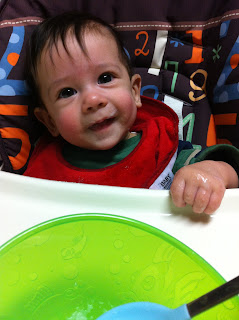Well, we have officially started Jude on baby food. He went for his 4 month check-up last week and now weighs 10 lbs. 10 oz and is 24.25 inches long. The doctor said he is a bit on the small side but he is growing and is healthy so he wasn't worried. He still recommended I start Jude on some cereal and pureed vegetables and fruits to help him put on some weight.
Now I'm excited. I have been planning to make my own baby food (at least the majority of it) since he was still in the womb and now I get to actually do it. I got a few books from my store about how to go about making it, what food do what for growth and bowel regularity and I could go on for a while. I'm a little nuts about it. I just want what is best for my baby bear and I think by controlling what he eats, what goes into it, etc. I can keep a better eye on him and keep him healthy.
Plus it's cheaper. Really. Have you seen the price of a jar of baby food? Ri-dic-u-lous.
Anyway, I want to share with you my first feeding adventure. We started Jude on just some rice cereal mixed with a little breast milk for a couple of days. Fun. He put up quite the fight the first feeding, but now he seems to enjoy it immensely. He laughs and talks and spends more time eating his fist than eating his food, but it's fun to watch. And he does eventually get the food down.
Then I decided to be adventurous and give him bananas. Well, I made the husband do it because I was at work. Babies like bananas, right?
Well, friends, Jude is allergic to bananas. Yikes!
He broke out into hives on legs and arms. Scared the crap out of my husband and later myself when I got home after work to find this out. He never seized up, or had trouble breathing, or anything more serious than some welts and redness that went away after an hour after feeding him so we didn't feel it was ER worthy. (Please trust that had they stayed we would have been there in a heartbeat.)
We figured no more bananas, that should fix it, right?
Wrong. He continued to break out for the next two days. Redness and welts that would come after feeding him but go away not long after. I was worried that perhaps it was my milk or the little bit of formula we were giving him, or perhaps we were bringing in something from the outside that he was reacting to, or just something other than the bananas was making him break out. Nope.
Thank you baby clinic that is open on the weekends for being my saving grace this past weekend. What they don't tell you about allergic reactions, and what I would like to share with the world, is that while the banana was gone from his system, what had triggered the response can stay for about 72 hours. Which means that he can continue to break out into hives for a few days afterward. But as long as his breathing was fine and his face didn't swell, there was no need to panic or take him to the ER according to the clinic doctor. Whew.
Thankfully, that was the worst of it, so no trips to the ER. He has stopped breaking out and we are only giving him cereal while his body recovers and gets rid of the nasty allergy stuff. I'll admit that I'm worried about giving him food now, but I'm going to remain positive and feed him some sweet potatoes next week.
Cross your finger that all goes well.



